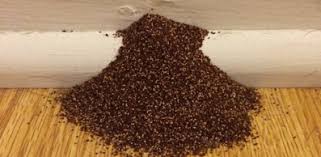Termite Control For House Fundamentals Explained
Reproductives that are darker in colour to castes, have functional eyes and strong skin. This caste becomes the pioneers of colonies.
The temperature, food quality, and activity of this colony will determine how long it takes to get a termite.
Nests and tunnels are kept moist because worker termites cannot stand low humidity for long intervals. The temperature within the nursery of a nest ranges between 10 C and 35 C but varies more than one level every day. The relative humidity is approximately 100 per cent.
It's important to correctly identify the type of pest infestation prior to beginning treatment. This can help you understand the habits of this colony, find the nest and indicate the most suitable method of control.
The 25-Second Trick For Termite Control For Lawns
Species are identified by their soldier termites, which has the most prominent features.
These termites are widely distributed throughout Victoria, and are responsible for more than 80 per cent of irreparable harm to buildings.

Coptotermes build nests in trees (preferring eucalypts), stumps, under concrete flooring, in wall cracks or enclosed verandahs.
Not known Factual Statements About Termite Control For New Construction
These termites travel at least 50 metres in the colony via a series of underground tunnels to find food. Coptotermes acinaciformis send substantial numbers to new food sources and, therefore, respond strongly to lure. In contrast, Coptotermes frenchi explore widely for new food sources and feed lightly at multiple points.
Nasutitermes exitiosus is common north of the Great Dividing Range. They construct dim, thin-walled mound nests between 30 cm and 75 cm above ground. These mounds are around 1m in diameter.
This is species of termite called dampwood termite. They are normally found nesting in massive parts of timber (especially older trees) and are most common in moist, mountainous areas. They can, however, also be found in the foothills of Melbourne.
Termite Control For House - Questions
Porotermes tend to reside in colonies than other species, and do not construct shelter tubes or traveling far underground. They're more easily controlled than other species.
A mature colony of Schedorhinotermes will possess two distinct sizes of soldiers, also called major and minor soldiers. Major soldiers grow around 5.6 mm long, while minor soldiers are only 3.6 mm long. Both types of soldier have mandibles.
Schedorhinotermes are harmful and relatively nomadic, rather than maintaining a fixed, central nest.
Top Guidelines Of Termite Control For New Construction
Heterotermes are widely distributed throughout Australia. But they are only a insect species in the Northern Hemisphere.
The soldiers of the species are up to 4.75 mm long, with lengthy, dark jaws and parallel-sided heads.
Heterotermes reside in small colonies that attack fence posts, timber flooring, and paling fences within a small radius of the nest. They are commonly found because they feed on small timbers on the soil next page surface.
Dusts work to control termites since they ingest and distribute the insecticide among the colony during habitual grooming.
The Termite Control For Lawns Statements
Insect growth-regulator dusts (like Triflumuron) and non-repellent termiticides are the safest means of termite dust control for the human consumer.
Arsenic trioxide dust has been used since the 1930s to control termites, often with the addition of oxide or another colourant. However, arsenic trioxide is a poisonous, highly poisonous elemental pesticide that does not degrade.
Some Ideas on Termite Control For Lawns You Should Know
Baiting is most often the ideal way to kill an attacking colony when the main nest site cannot be found. Bait stations also allow you to collect samples of termites for species identification.
Bait stations consist of containers of cellulose materials like wood, paper or cellulose gel which are either buried in the ground near the building under attack or carefully positioned inside near known damage.
Bait generally utilize slow-acting, non-detectable toxins in order that the nearly complete colony can be poisoned before adverse impacts appear. Repellent termiticide formulations such as those of all pyrethroids are not as colony control agents. Care must be taken not to cross contaminate baits with even tiny residues of other pesticides.
Baiting does not supply a barrier that is practical. The baits do not isolate the building since termites continue to be able to get the construction. For long-term structural protection, barriers are preferred.
Termite Control For House Things To Know Before You Get This
Chemical barriers function by applying an unbroken boundary of pesticide around the outside of an infested structure. This creates a zone or band of soil that is poisonous that the termites cannot cross. Creating an effective chemical barrier could involve trenching around the foundations of the construction, and injecting the chemical into the soil through holes drilled in concrete foundations.